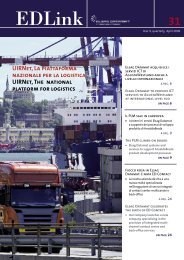Scarica numero di ED Link - Elsag Datamat
Scarica numero di ED Link - Elsag Datamat
Scarica numero di ED Link - Elsag Datamat
Create successful ePaper yourself
Turn your PDF publications into a flip-book with our unique Google optimized e-Paper software.
TECHNOLOGY<br />
Developed by I.Log and<br />
Metrocargo Automazioni,<br />
this system lies at the heart<br />
of slimCARGO (one of thirteen<br />
slimPORT sub-projects),<br />
using an innovative horizontal<br />
movement technique<br />
that operates beneath overhead<br />
power lines to move<br />
containers from wagons to<br />
track-side stocking areas<br />
and vice versa. This totally<br />
eliminates the cost and time<br />
associated with railway manoeuvres<br />
(coupling and decoupling<br />
wagons, their<br />
transfer from one area in<br />
marshaling yards to another,<br />
and train composition<br />
and breakdown) essential in<br />
a tra<strong>di</strong>tional terminal,<br />
where trains need to be removed<br />
from the electrified<br />
line for unloa<strong>di</strong>ng. A Metrocargo<br />
terminal, on the other<br />
hand, can unload and reload<br />
an entire train in about 40<br />
minutes. Clearly this increases<br />
the capacity of a rail<br />
terminal exponentially, significantly<br />
reducing operating<br />
costs and times and<br />
minimizing the cargo breakbulk<br />
han<strong>di</strong>cap.<br />
Looking at the construction<br />
technology in more detail,<br />
the system uses purpose<br />
built shuttles and towers<br />
mounted on specially designed<br />
trolleys to lift containers;<br />
it is also modular, so<br />
that terminals can be<br />
Il portale<br />
The portal<br />
merci su rotaia simile, quanto a costi e tempi, al trasporto passeggeri.<br />
Utopia? No. Metrocargo è proprio questo, una tecnologia<br />
grazie alla quale un treno è in grado <strong>di</strong> fermarsi in un<br />
terminal, caricare e scaricare anche poche unità <strong>di</strong> carico e ripartire<br />
nel giro <strong>di</strong> alcuni minuti.<br />
Sviluppato da I.Log e da Metrocargo Automazioni, il sistema è<br />
alla base <strong>di</strong> slimCARGO, uno dei tre<strong>di</strong>ci sottoprogetti <strong>di</strong> slim-<br />
PORT, e utilizza un’innovativa tecnica <strong>di</strong> traslazione orizzontale<br />
che opera sotto la linea <strong>di</strong> alimentazione elettrica dei<br />
locomotori per movimentare i container dai vagoni all’area <strong>di</strong><br />
stoccaggio a<strong>di</strong>acente al binario e viceversa. Ciò azzera totalmente<br />
i costi e i tempi legati alla cosiddetta “manovra ferroviaria”<br />
(che comprende l’unione e il <strong>di</strong>stacco <strong>di</strong> rotabili nonché<br />
il loro spostamento da un posto all’altro e l’esecuzione dei movimenti<br />
necessari per comporre e scomporre i treni), imprescin<strong>di</strong>bile<br />
in un terminal tra<strong>di</strong>zionale, in cui il treno per poter<br />
essere scaricato deve essere necessariamente tolto dalla linea<br />
elettrificata. Un terminale Metrocargo, invece, consente <strong>di</strong> scaricare<br />
e ricaricare un intero treno in circa 40 minuti. È ovvio che<br />
ciò incrementi esponenzialmente la potenzialità <strong>di</strong> un terminal<br />
ferroviario, riducendo significativamente i costi e i tempi<br />
operativi e minimizzando l’han<strong>di</strong>cap delle rotture <strong>di</strong> carico.<br />
• L’inizio del vagone viene identificato<br />
grazie a due spot laser che rilevano la<br />
posizione dei respingenti.<br />
• Il laser verifica la presenza del container<br />
quando il vagone transita davanti<br />
al portale.<br />
• Se il container è presente, vengono<br />
scattate le foto per la documentazione<br />
e per la lettura ottica della matricola<br />
del container.<br />
• Quando i laser in<strong>di</strong>viduano i due respingenti<br />
successivi, il sistema registra<br />
la fine del vagone e l’inizio del successivo.<br />
• Alla fine del treno, tutte le informazioni<br />
elaborate dal software vengono composte<br />
per ottenere il sinottico del treno.<br />
• The start of the rail car is identified<br />
using two spot lasers that detect the<br />
position of the buffers.<br />
• The laser verifies whether or not a<br />
container is present as the car moves<br />
through the portal.<br />
• If there is a container, photographs<br />
are taken for documentary purposes<br />
and to read the container registration<br />
number (OCR).<br />
• When the lasers identify the two subsequent<br />
buffers, the system records<br />
the end of one car and the start of the<br />
next.<br />
• At the end of the train, all the information<br />
processed by the software is<br />
assembled to produce a mimic <strong>di</strong>agram<br />
of the train.<br />
22<br />
planned accor<strong>di</strong>ng to the<br />
space available and the<br />
number of containers handled.<br />
The technique used is<br />
high performance, reliable<br />
(as demonstrated by the<br />
eight-week stress test performed<br />
jointly by I.Log and<br />
<strong>Elsag</strong> <strong>Datamat</strong> and completed<br />
last July 26) and perfectly<br />
consistent with the<br />
goal of minimizing environmental<br />
impact, because<br />
both atmospheric and<br />
acoustic pollution are almost<br />
totally eliminated by<br />
the electrically-powered automation<br />
system.<br />
In the slimCARGO subproject,<br />
the Metrocargo system<br />
is integrated with other<br />
technologies developed by<br />
COME FUNZIONA IL PORTALE PER L’IDENTIFICAZIONE<br />
DELLA COMPOSIZIONE DEL TRENO?<br />
HOW DOES THE TRAIN COMPOSITION PORTAL WORK?<br />
Laser<br />
Firewire<br />
cameras<br />
L<strong>ED</strong><br />
Illuminators<br />
OCR<br />
camera



